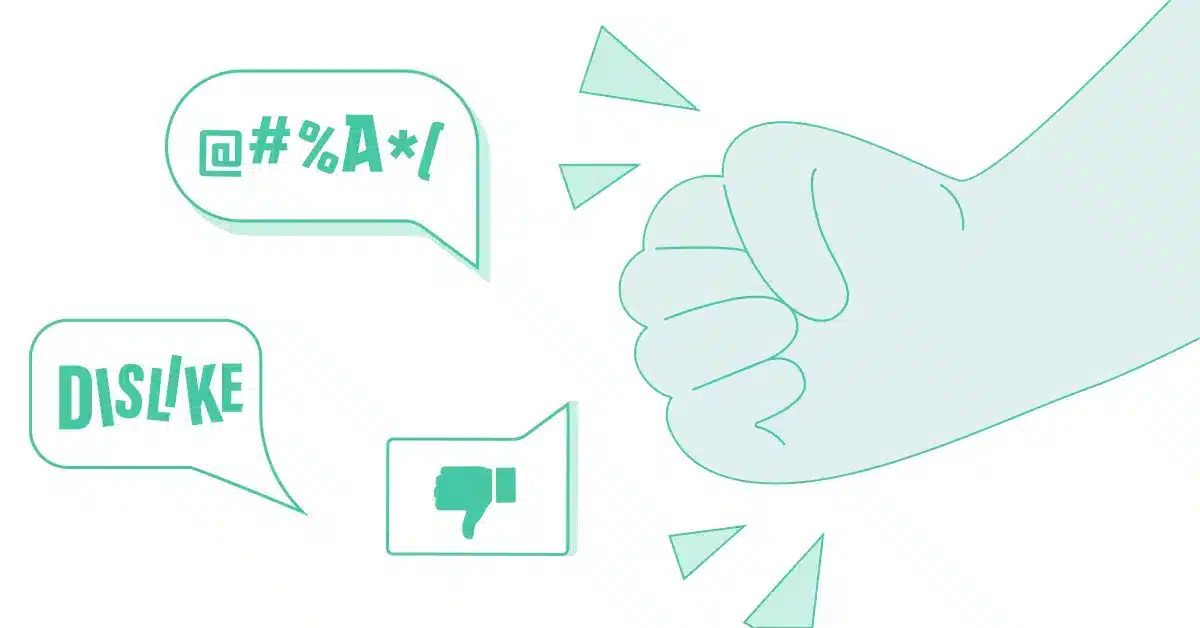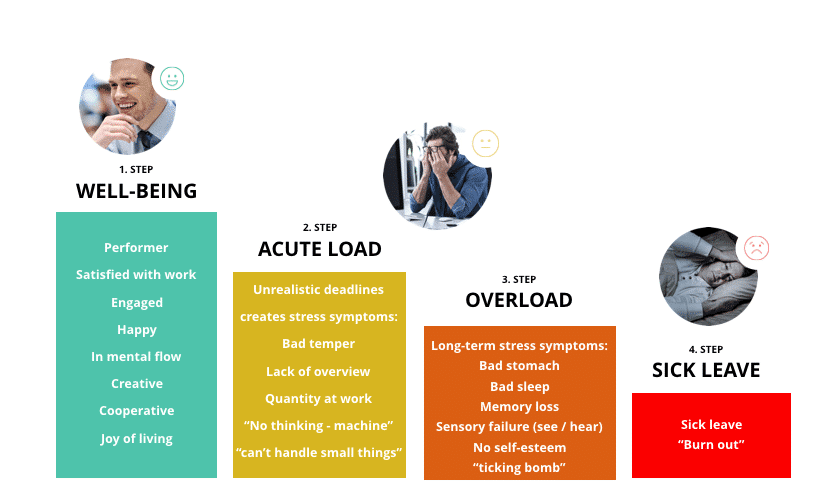More than 81 % of our surveys show cases of ‘offensive actions’.
‘Offensive actions’ is an umbrella term that includes bullying, sexusual harrasment, physical violence and threats of violence are characterised. In this article I will focus on: violence at the workplace.
First of all it is important to mention the fact that many workplaces will never experience problems with violence.
Nonetheless, it is still everyday life for many employees in Denmark why it is important to take a closer look at it.
But what is workplace violence?
According to the Occupational Safety and Health Administration of the United States
“Workplace violence is any act or threat of physical violence, harassment, intimidation, or other threatening disruptive behaviour that occurs at the work site. It ranges from threats and verbal abuse to physical assaults and even homicide. It can affect and involve employees, clients, customers and visitors”
Now we have the definition in place.
But ‘psychological violence’ can also happen through social media, text messages, emails and websites.
‘Psychological violence’ that takes place on social media uses the same mechanisms as other forms of psychological violence. It affects the victim’s self-esteem, creates anxiety and discomfort. The psychological violence through social media can seem extra harmful because it is anonymous.
We therefore always recommend our customers to have a clear zero tolerance policy about physical and psychological violence and documented guides for preventing.
Which industries carry the highest risk of workplace violence?
The level of workplace violence differs from country to country. But research has identified some industries that are more likely to be at higher risk toward workplace violence. The National Institute for Occupational Health and Safety (NIOSH) reports that the national industry of workplace violence 1.8 assaults per 100 employees but these industries has the highest incidents of workplace violence:
Social services (with 14 assaults per 100 employees)
Health services (9 assaults per 100 employees)
There are many reasons for that. An example is when working at a hospital you ofent work with unstable people. Or in the social sector you sometimes work isolated in areas with high crime rates.
Based on our surveys, particularly two industries stand out.
Customer Success Manager here at Woba, Kira Lund Probst, says:
“I find that employees in the Hotel and Restaurant industries as well as in telemarketing are most often exposed to workplace violence. And here, we are talking about the external violence in the workplace. Not between the employees, but violence or threats from customers and dissatisfied guests.”
And she goes on:
“… But I also see threats of violence in the workplace across all industries in the relationship between manager and employee. I have experienced that a director of a large Danish company threatened the employees that they would not be allowed to go on their contractual breaks if they wanted to keep their jobs. This is also a form of threat and a clear example of how poor management can lead to dissatisfaction and an unsafe work environment.”
So violence and threats of violence can be many things and many situations. The most important thing is that it is NOT tolerated or neglected in any form.
If you have an employee who feels violated and exposed, it must be taken very seriously. Actually, both proactively and afterwards.
So, there are two tracks you need to focus on here – how to identify it and how to prevent and reduce it.
Let’s start with how you can identify workplace violence.
How do you identify workplace violence?
An “easy” way for you to identify if you have problems with violence at your workplace is to measure it!
It is furthermore required by law that you ask your employees about the simple question – ‘have you experienced violence in the workplace – or threats of violence in the workplace? – in the mandatory Health and Safety Risk Assessment. Hereby it is possible for you to identify the risk factors.
When the survey is completed it is easy for you to identify if your employees are in the “red” or “green” zone. Red zone means that your employees are exposed or worse already victims of violence at work.
If you have identified that workplace violence is taking place, we highly recommend that you take appropriate precautions. One of the best protective actions a company can take is to:
Zero-tolerance policy: Define and implement a zero-tolerance policy toward workplace violence
Workplace prevention program: The policy should also include an actionable workplace prevention program where managers easily can understand how they can prevent or minimise the risk of violence toward their employees
Make it available for everyone to increase awareness: if you really want to see an effect on the reduction of violence then you must make sure that the policy and prevention program is available and understood by everyone!
…. And most importantly: prevent – RIGHT away!
Prevent – RIGHT away!
No one should be exposed to violence or threats!
When it happens anyway, it is important that you take action the right way.
But imagine if you could deal with it upfront – i.e. prevent it?
You can actually!
First of all, you need to assess the risk. According to the Work Environment in Denmark authority, you must make an assessment based on the following parameters:
– The risk posed by clients or citizens
– Where and when there is a risk of episodes of violence
– The types of violence involved
– How serious the episodes might be
– Whether some groups of employees are particularly vulnerable
– Whether there is a risk that employees will be exposed to work related violence outside of working hours
Clearly, the more work you put into this risk assessment, the better equipped the company will be in terms of future prevention and management.
In addition, you must also pay attention to the actual planning of the work. A well-founded work schedule can ensure a reduced risk since, in this way, you can ensure that no one works completely alone and thus is even more exposed.
Training and instruction are essential
If there is a risk of violence in the workplace, you, as an employer, will not be able to avoid ensuring the proper training and instruction of all employees.
Employees must both be trained in dealing with any episodes of violence and at the same time be trained in how to limit the seriousness of situations that have arisen. Much can be stopped before it escalates, which all else being equal is the preferred scenario, so make sure the right instructions are given.
The training and instruction must not only be limited to risks during working hours. Be sure to implement firm guidelines and teach employees how to handle episodes – also outside of work hours.
De-risk your decor
If it has been assessed that there is a risk of violence where you are, you can come a long way by taking a close look at your decor:
Reduce the risk by:
– Decorating according to known reaction patterns from clients and citizens
– Carrying out personal conversations with clients and citizens in rooms where the conversations can take place discreetly
– Avoid loose objects such as potted plants and porcelain in the room. Remove all effects that can be used as objects to throw or as weapons
– Consider whether the design may be more appropriate for the individual citizen / client / customer. It could be establishing single rooms etc.
– Establish escape routes
– Escape is the most appropriate response in most cases.
It is therefore your responsibility, as an employer, to ensure a sufficient number of escape routes for your employees.
It should be easy and quick to get away if the risk of violence suddenly arises.
Requirements for guidelines for public workplaces (Work Environment in Denmark Authority):
“Public workplaces in municipalities and counties must have guidelines for the work of identifying, preventing and dealing with violence. This has been agreed between employer organizations and employee unions in the public sector that implements a similar agreement at EU level.
Even though the workplace already has guidelines, this requirement is a good opportunity for you as an employer and for your employees to discuss how you perceive and handle these problems, and to assess whether there is a need to revise existing procedures.”
If you are a public sector employer, you must therefore be aware of these guidelines so that all rules are complied with – and all employees are in the safest environment possible every day when they attend work.
Are you part of The Occupational Health and Safety Organisation?
Then you have a crucial responsibility.
The Occupational Health and Safety Organisation plays an extremely important role in prevention.
The occupational health and safety organisation must:
– Participate in the prevention of health and safety risks, including the risk of violence
– Participate in investigations of episodes of violence and run-ups to episodes of violence
– Advise the company on solutions in relation to the risk of violence
– Check if the selected solutions are effective
– Once a year, compile an overview of accidents in the company, including episodes of violence
– In addition, establish principles for adequate and necessary training and instruction. It is therefore important that The Work Environment Organisation has the necessary knowledge about the risks of violence and about preventing violence.
Where there is no work environment organisation, the above tasks are handled by the employer in collaboration with the employees.
(Source: at.dk / https://www.osha.gov/workplace-violence)
Preventing violence using equipment?
With the right equipment, you can prevent violence in many instances, yes.
In any case, it is important that a proper attempt is made. And this can be done using alarms and surveillance, for example.
In order to prevent an escalation of an episode of violence, it is important that employees can activate the equipment simply and discreetly.
In some types of jobs, it may be necessary to make use of technical aids such as assault alarms, surveillance cameras and call systems. Such aids can create greater security and safety for the staff.
As an employer, if you want to use technical aids in the company, you should discuss and prepare with your employees:
Expectations for the aids
– Procedure of how to introduce the aids to new employees
– Guidelines for the use of the aids
– Procedure for maintenance and testing
– At the same time, you should consider together how to prevent alarms and surveillance from affecting the contact and communication with the citizen or client.
It is a JOINT effort!
The employer has the formal responsibility of ensuring sound working conditions in terms of health and safety.
However, everyone in the workplace plays a role in preventing violence. This means that the work must take place on four levels; those of the Individual, the Group, the Leadership and the Organisation, also called the IGLO model.
You can access Woba’s recommendations for prevention and actions based on IGLO here >>> Download eBook
Your employee has been subjected to violence! – What to do?
As an employer, your most important task now is to make sure that your employee has access to physical and psychological first aid after the episode of violence.
And this actually also applies to the employees who may have “only” witnessed the episode. They can be just as affected afterwards – and this needs to be dealt with as well.
Mental first aid is not the well-known therapy or psychological crisis help, in the way we usually understand it. Rather it is actions to show that the employee isn’t being left alone by herself or himself.
It is often seen that the victim cannot manage to seek help and support, so it is incredibly important that the person who provides psychological first aid takes the lead in reaching out.
In addition, make sure that all colleagues are informed about the episode of violence and, not least, about the expected reactions from the victim of violence that they need to be aware of.
Teach employees first aid
As an employer, you must appoint the people in the workplace who will be responsible for first aid. They must receive the necessary training, constitute a sufficient number and have suitable equipment at their disposal, for example, a first aid kit and blankets.
Employees must know the content of workplace first aid measures.
Advice for the helper – directly from the Work Environment in Denmark authority
Are you appointed as a helper?
There are some clear guidelines you need to be aware of when you are in the actual help situation. These are both important “DO’S” – and, in particular, also important “DON’TS”.
DO’S – when you provide psychological help:
– Create peace around the victim, e.g. by shielding the victim from curious onlookers and finding a suitable room.
– Take control, maintain the overview and speak clearly and distinctly
– Listen kindly, patiently and attentively to the victim who may need to talk about the episode several times
– Give short messages about how the episode of violence is handled in the workplace.
DONT’S – when you provide psychological help:
– Probing into – and interpreting the victim’s feelings and experiences
– Talking about your own experiences
– Being instructive, stifling or trivialising
– Giving unrealistic promises
– Before the victim of violence goes home
– The victim may well be shocked or dizzy, and the designated helper must then make sure that he / she is driven home – and isn’t alone at home.
– Severe after-reactions may occur, and it must be ensured that the employee is in a safe environment with someone around.
– You must also consider whether agreements should be made with the victim about the course of events for the coming days and weeks. For example, there may be a need for sick leave or a visit to the doctor.
– It may be a good idea to provide the victim with written material about expected reactions and what reactions he or she must be aware of in relation to contacting, for example, the GP, a psychologist or a psychiatric emergency room.
Take a stand and ensure visibility!
It can be useful to make a list with telephone numbers of the employees who are to be in charge of first aid, and with the alarm central and the police, and place the list where it is visible to all employees.
It can also be a good idea for the individual employees to decide which colleagues they want help from in a crisis situation and which relatives must be notified in the event of episodes of violence.
If you have this completely under control, you will avoid all unnecessary chaos and confusion if the situation should arise against all odds.
When to report?
An episode of violence is considered a work accident.
As with all other accidents at work, you, the employer, have a duty to report the episode of violence if the episode results in absence from work exceeding the day the episode of violence took place.
As an employer, you also have a duty to record and evaluate the episode. Based on this, you should have to assess whether the company’s prevention plan may need to be re-evaluated.
Get a valuable Guide for Incident Report right here – https://safetyculture.com/topics/incident-report/
Follow up and support!
Being exposed to violence may leave deep scars.
You may think that you are completely unaffected. Yet you may suddenly experience after-reactions.
It is of utmost importance that you, as an employer, follow up with your employee and show awareness of her or his mental state for a while.
Plan and conduct a follow-up with the employee.
You must, in fact, do this with all parties involved (including witnesses).
There is no set limit as to how long after post-reactions may occur. It is a very individual thing.
So depending on the nature of the episode and the employee’s own history, after-effects may occur and extend over days, weeks, months and, in the worst case, years.
It is your responsibility as an employer to keep up to date with the state the employee is in – long term also.









